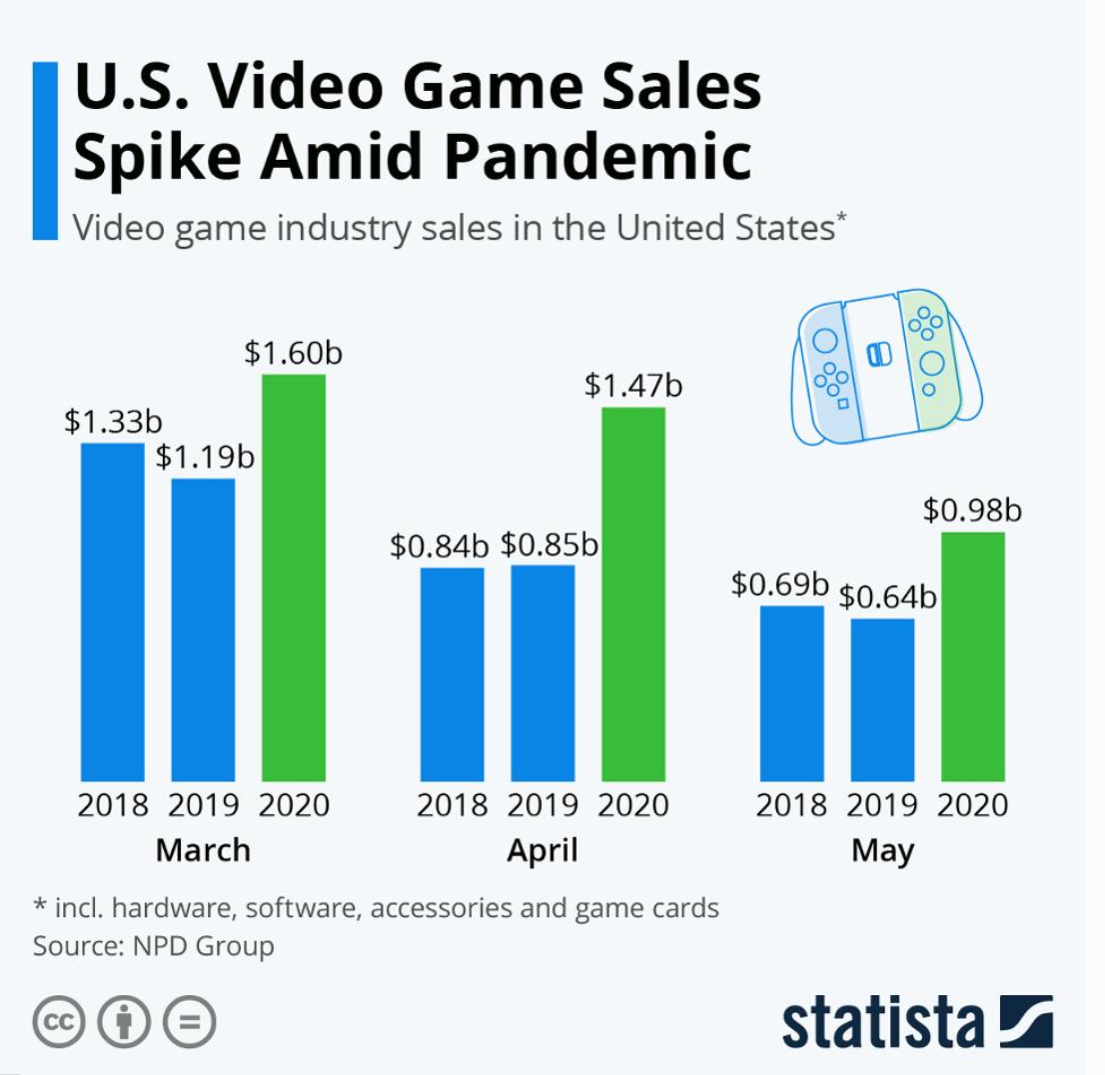Gaming Industry Sees Big Growth While People Stay Home

As soon as people were ordered to stay home in response to the Covid-19 pandemic, consumers have had a number of ways to spend their added time at home—including play games. As the chart below shows, the increases in gaming revenue has been huge, month to month, since March. In March of this year, gaming, over March of 2019, is up 34% in spending. In April of this year, gaming was up 73% over last year, same month. And this past month, May, was up 53% over May of 2019.
Game industry sales way up in March, April and May of this year.
US video game sales spike March-May 2020. NPD/STATISTA
“Video game engagement and revenue across all platforms, including console, PC, mobile, and VR, grew globally during the Covid-19 lockdown. Video gaming is considered an affordable and accessible form of entertainment, and existing and new gamers across all demographic groups found emotional and social support in these virtual worlds. The digital transition that began a decade ago through digital downloads, games-as-services, and mobile app stores has paid off for the industry,” said Michael Cai, president of Interpret, a global video game insights agency.
Stan Kwon, CEO of Beta Hat, a market and consumer insights agency specializing in gaming, media, and emerging technologies, confirmed the rise in gaming over the last few months. “Based on a recent survey we conducted among adult gamers in the U.S., almost 60% say that they’re spending more time playing games now than they were prior to stay-at-home orders going into effect.” Kwon also reported that he sees Americans “choosing to play a wider variety of games rather than sticking to the same games they were playing before” the stay-at-home order.
Further evidence of the rise in consumer engagement with gaming during this pandemic is that Unity Technologies, the real-time 3D software development platform company, has reported that mobile game ad revenue grew 59% during April 2020 compared to April the year earlier. Unity has also reported that in-app purchases in games rose 24% in March and April of this year.

There are many different types of games available to consumers on consoles, computers, and their smartphones. About 70% of the U.S. population at least occasionally plays some sort of video or mobile game. The breadth of games available to consumers are shown in this chart that looks at the most popular game titles over the years.
Rob Dyer, chief operating officer of Capcom in the U.S., spoke to the increase in gaming seen worldwide. “While we believe there has been an increase in the frequency of people playing games given the current restrictions on going outdoors, it is possible that less leisure time will be available in the future due to factors such as reduced summer vacation time.” Dyer went on to say, “We hope our games will continue to be a source of enjoyment for people everywhere facing these challenging times.”
While it is clear that consumer engagement with gaming has increased as people have had more time at home, but what will happen when the world goes “back to normal” and time at home goes down? Michael Pachter, research analyst at Wedbush Securities and a well-known expert in the field of gaming, points out, “It’s incumbent on the gaming companies to retain the new and lapsed players” down the road.
By:Mike Vorhaus

熱門頭條新聞
- Milan Games 2025
- Bluey animated film announced by Disney+ and BBC Studios
- New Program Confirmations – Forum is Open for Bookings
- A Brand New Indie Title, Steel Knight’s ARMIS
- Subscriptions to Free Streaming: The Platforms and Formats Redefining Entertainment
- New AI Research Foreshadows Autonomous Robotic Surgery
- Magia Exedra – More Than 400,000 Pre-Registrations Achieved!
- Mufasa: The Lion King
